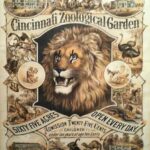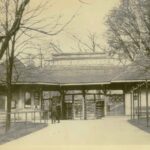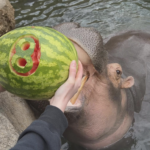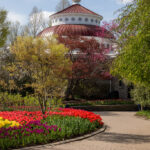by Collette McDonough, Advocacy and Outreach Committee member.
This year, the Cincinnati Zoo & Botanical Garden are celebrating their 150th anniversary. Since June is National Zoo and Aquarium Month, it seems the perfect time to shine a light on the history of this amazing zoo in our state. They were created in 1873, but the zoo itself did not open until September 1875. It started with only a handful of animals including, two grizzly bears, three deer, six raccoons, two elk, a buffalo, a tiger, an elephant, eight monkeys plus a few other animals. In this 150-year period, the Cincinnati Zoo & Botanical Garden has risen to be one of the top-rated zoos in the country.
The Cincinnati Zoo was first known as the Cincinnati Zoological Garden and was founded by German immigrants that longed for the beauty of the gardens in their homeland. The main person behind the creation of the zoo was Andrew Erkenbrecher, whose family moved to the Cincinnati area in the 1830s. He then went on to become a wealthy merchant. Mr. Erkenbrecher and other well-off German families wanted to have a zoological park like they had in Germany that would be like the zoos of Berlin and Cologne.
According to The Cincinnati Enquirer, the zoo opened in September 1875 to enormous crowds that caused the omnibuses and streetcars to groan under their human freight. The article numbered the attendance as around ten thousand people. Like many grand openings, there were a few struggles. The paper reported that a leopard escaped its enclosure, and an elephant broke its chain. Thanks to a brave keeper, they were able to contain the former circus elephant. The article notes, however, that, as of the time of writing, the leopard was still at large, which might mean that Governor Noyes, a Republican whom the Enquirer did not support, would not desire to give any speeches in the Cincinnati area for some time (The Cincinnati Enquirer, Mon, Sep 27, 1875, page 4). Even before the zoo project was finished, the Enquirer declared it to rival those of Europe and to be better than zoos in larger cities (The Cincinnati Enquirer, Tue, Nov 03, 1874, page 4).
By the early 1900s, the “Cincinnati Zoological Garden was a leader in the naturalized look going so far as to give rise to barless exhibits.” The original intent was for a botanical garden to be developed nearby, but this concept was abandoned due to a lack of funds. Instead, the gardens were incorporated into the design. “During the turn of the century, Cincinnati’s Zoological Gardens included Victorian era gardenesque strolling gardens often found on wealthy private estates. But these were accessible to everyone in Cincinnati. These gardens showed off formal flower “cushion” or “carpet” beds popular at the time.” Quotes from the 150th anniversary website.
There have been numerous significant moments at the Cincinnati Zoo in the past 150 years. The last passenger pigeon, Martha, died at the zoo in 1914. Passenger pigeons once flew in huge flocks across North America but were hunted to extinction in the wild in Ohio by 1900. A more recent notable event was the birth of Fiona the hippo, who was born six weeks prematurely in 2017. Fiona weighed only 29 pounds at birth and was too small to be nursed by her mother so was cared for by the staff. The public was fascinated by her story, which was regularly updated on the zoo’s website and Facebook page. There are now Fiona children’s books, ornaments, and t-shirts. She is likely the most famous resident of Cincinnati.
Over the years the Cincinnati Zoo has expanded its role from a local place to enjoy beautiful animals and plants to a major leader of the conservation movement in the United States through its program called the Coexistence Coalition. Some of the goals of the program are to build up positive approaches to wildlife within local communities and to “design interventions to enhance coexistence that are ecologically suitable, economically viable, and socially acceptable.”
The Cincinnati Zoo has resources available such as Plant for Pollinators that list the types of plants that are best for pollinators in the Midwest. In the spring and fall, the zoo hosts a native plant sale at the Bowyer Farm in Mason, OH. The spring dates have passed but be sure to check in August when the fall dates are announced. Please note that this is an event that requires registration.
In May, SOA was able to chat with Thane Maynard, Director of the Cincinnati Zoo & Botanical Garden.
SOA: What does the Cincinnati Zoo & Botanical Garden have planned for the 150th anniversary?
Maynard: Well, it is going to be a year-long celebration. We have planned new habitat openings, two of which opened in the spring. The next ones, Sea Otter Coast and Bear Ridge, will open in the fall. We also launched a fun pin-trading program with exclusive pins that will no doubt become collectors’ items. September will be the most festive, since that is that actual anniversary month.
SOA: How have zoos changed in the past 150 years?
Maynard: In the 1800s, zoos were mostly a form of entertainment and were often just menageries. Now we are focused much more on conservation and education. Our daily working motto is that the zoo is here to inspire every visitor with wildlife every day. We are very committed to being the greenest zoo in America. The water in Fiona’s pool is from rainwater. The new elephant habitat sits on top of a giant reservoir for that rainwater. We have been able to drastically cut our water usage thanks to these measures. We also utilize solar energy. You can’t miss the two giant solar arrays that are over our parking lots.
SOA: What is something that most people wouldn’t know about the Cincinnati Zoo?
Maynard: The Cincinnati Opera’s original home was the Cincinnati Zoo. The opera held performances at the Zoo from 1920 to 1971. We in fact, still have members of the Opera come to the zoo for Zoo Opera days.
SOA: How are you planning on using historical materials to celebrate this anniversary?
Maynard: Many of our historic photos from years past are on the historical interactive timeline on our website. We also have featured many historic videos and photos on our new 150 – Second Stories video series. You can find these on our website and on YouTube. They are a great resource.
SOA: We hope that many of you will be able to enjoy some of the historical photos the Cincinnati Zoo & Botanical Garden have gathered online. Better yet, we hope that you all will be able to enjoy a day at the zoo during this year while they celebrate this milestone. All the images were provided by the Cincinnati Zoo & Botanical Garden.
Last Updated on June 17, 2025 by Emily Gainer





